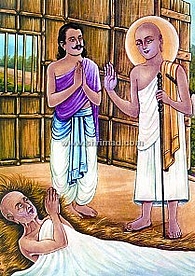
Federation Of Jain Associations in North America

| President's Message | |||
 Jai Jinendra! Jai Jinendra!A new Jainism Chair has been installed at University of North Texas in Dallas. We now have Jain studies being offered in 10 major academic institutions. We are thus increasingly sharing Jain values with our inter-faith Communities across USA through such programs. Thanks to all who submitted essays on “Practicing Ahimsa in our daily life”. Congratulations to Rachna Shah, a teenager from Chicago, for her outstanding essay which is published below. Sincerely, Ashok Domadia JAINA President Chairman - JAINA BOD | |||
| Quote of the week | |||
| If one's vision is capable of expelling the darkness, he would not need a lamp. Likewise the soul itself being blissful, there is no need of external object for bliss. - Mahavira (Pravachansara, 1/67) | |||
| KNOW YOUR TIRTHANKAR - Sumatinath Bhagwan | |||
|
Once upon a time a trader went to earn money with his two wives. While returning the trader died in an accident,leaving his only son has heir. The son was bought up by both the wives of the trader. As time passed the other wife who had no child started feeling insecured for her future as the son was the only heir and eventually she wouldn’t get any of her husband’s wealth. As a result of this, she started claiming that the child belonged to her and she was the real mother. This fight took them to King Meghrath. For the King and his courtiers, it was next to impossible to decide who the real mother was. After a lot of discussion the court astrologer came to a conclusion and said that Queen Sumangala was going to give birth to a Tirthhankar and would be possible for the Tirthankar to decide who the real mother was due to Avdhik Gyan. After listening to this the real mother immediately reacted and requested for a faster judgment as she wasn’t ready to keep her child with the other wife even for a moment. As soon as she said this, Queen Sumangala who was in the court, suddenly realized the importance of what the real mother was saying and also noticed that the other wife was silent. She immediately told King Megrath and justice was done to the real mother. This was only possible due to her child who had a soul of a Tirthankar and that is why he was named Sumatinath Bhagwan because Sumati means intelligence. | |||
| Installation Ceremony of the “Bhagwan Adinath Professorship of Jain Studies” at UNT | |||
 “By endowing this Chair, you have done a great deal in keeping alive and publicizing a very vital and relevant part of the intellectual heritage of humanity,” so said Dr. Anupam Ray, the Indian Consul General based in Houston, who was the Chief Guest at the Installation Ceremony of the “Bhagwan Adinath Professorship of Jain Studies” at the University of North Texas in Denton, Texas on September 30, 2016. “By endowing this Chair, you have done a great deal in keeping alive and publicizing a very vital and relevant part of the intellectual heritage of humanity,” so said Dr. Anupam Ray, the Indian Consul General based in Houston, who was the Chief Guest at the Installation Ceremony of the “Bhagwan Adinath Professorship of Jain Studies” at the University of North Texas in Denton, Texas on September 30, 2016. In Dr. Ray’s words, this ceremony celebrated “learning, life, America, India, the Jain faith, and philanthropy” all rolled into one. It was attended by about 250-300 people including the Inaugural Bhagwan Adinath Professor, Dr. George James; the UNT President, Dr. Neal Smatresk, and the Dean of its College of Arts & Sciences, Dr. David Holdeman; JAINA Leaders, Jain Education and Research Foundation leaders; and the members of the Jain communities of Dallas and Miami. | |||
| ESSAY COMPETITION WINNER | |||
| Thanks to all the participants for their valuable inputs on Practicing Ahimsa in our Daily Life. We received many entries and winning essay is published below. | |||
| Practicing Ahimsa In Our Daily Life | |||
|
| |||
| JAIN CENTERS NEWS | |||
| Jain Study Center of North Carolina | |||
 Jain Study Center of North Carolina had organized Camp Lalit in first week of October. It turned out to be gorgeous; a great environment for soaking in our religious teachings. Camp Lalit was another success this year. Samaniji Vikas Pragyaji and Samaniji Maryada Pragyaji, who led in several discourses, with the main topic on 'Understanding Joy and Sorrow'. Samaniji Maryada Pragyaji also led the kids on some great interactive teachings of Jainism and a fun use of Cricket to learn about Jainism! Jain Study Center of North Carolina had organized Camp Lalit in first week of October. It turned out to be gorgeous; a great environment for soaking in our religious teachings. Camp Lalit was another success this year. Samaniji Vikas Pragyaji and Samaniji Maryada Pragyaji, who led in several discourses, with the main topic on 'Understanding Joy and Sorrow'. Samaniji Maryada Pragyaji also led the kids on some great interactive teachings of Jainism and a fun use of Cricket to learn about Jainism! | |||
| YJP | |||
|
| |||
| YJA | |||
| YJA recently finished taking in applications for Local Representatives - these are youth who give their time to be leaders in organizing YJA programs and events in their communities all across the country. We are lucky to have dozens of LRs supporting our Regional Coordinators and helping connect as many youth as we can reach! | |||
| Jain Story: Anand Shravak | |||
 Once upon a time, there lived a king named Jitshatru in the city of Vanijya. There also lived a rich householder named Anand in the same city. He was so rich that he had 4 million gold coins, an equal amount of cash, an equal amount already invested in business, lots of jewelry, and many other assets. He also owned 40,000 cows. He was highly respected by the king as well as the people of the town. Once upon a time, there lived a king named Jitshatru in the city of Vanijya. There also lived a rich householder named Anand in the same city. He was so rich that he had 4 million gold coins, an equal amount of cash, an equal amount already invested in business, lots of jewelry, and many other assets. He also owned 40,000 cows. He was highly respected by the king as well as the people of the town. One day, Bhagwan Mahavir visited this town and gave a sermon. After listening the sermon of Bhagwan Mahavir, Anand decided to accept the twelve vows of a householder. Anand observed these vows for fourteen years and then decided to renounce worldly affairs. So he talked to his children, handed over all his businesses and family responsibilities to them, and told them… | |||


